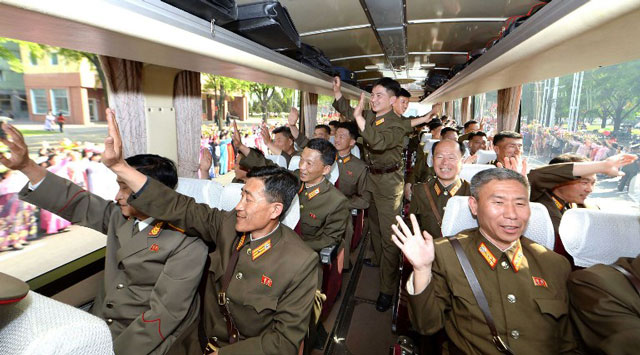
Seoul, South Korea | AFP | North Korea on Monday declared its medium-range Pukguksong-2 missile ready for deployment after a weekend test, the latest step in its quest to defy UN sanctions and develop an intercontinental rocket capable of striking US targets.
The state-run Korean Central News Agency said the North’s leader Kim Jong-Un oversaw Sunday’s launch, which sparked a fresh chorus of international condemnation and threats of tougher sanctions.
The missile tested was the Pukguksong-2, which uses solid fuel that allows for immediate firing, KCNA said.
So far almost all the North’s missiles have been liquid-fuelled, which have to be painstakingly filled with propellant before launch, while solid fuel missiles can be fired far more rapidly.
That would dramatically shorten the time available for any attempt to intervene and prevent a launch, requiring any such decision to be taken much more quickly.
Seoul military officials have previously said the Pukguksong-2 — a land-based version of Pyongyang’s submarine-launched weapon — uses solid fuel.
Kim said “with pride” that the Pukguksong-2 was a “very accurate” missile and a “successful strategic weapon”, KCNA said, adding he “approved the deployment of this weapon system for action”.
The launch “completely verified” the reliability and accuracy of the device, and its late-stage warhead guidance system, KCNA said, adding the test results were “perfect”.
Images carried by the Rodong Sinmun — the official mouthpiece of the ruling Workers’ Party of Korea — showed a smiling Kim clapping surrounded by his aides in an outdoor observation post as the missile shot up into the air.
It also had several pictures of the Earth said to have been taken from the rocket from space — the first such pictures released by the North.
Kim “said he was very happy to see pictures of the Earth taken by our rocket and that the world looks beautiful”, KCNA said, adding that he ordered the missile to be “rapidly mass-produced”.
– UN emergency talks –
The missile, which was described by Washington as medium-range, was fired from Pukchang in South Pyongan province and travelled about 500 kilometres (310 miles) before landing in the Sea of Japan, according to the South’s armed forces.
The rocket used a cold-launch system, KCNA said.
The technology uses compressed gas to propel a missile upwards before its engine ignites in mid-air. It is considered safer and also makes it easier to hide the launch location.
A spokesman for Seoul’s Joint Chiefs of Staff told reporters that South Korean and US intelligence authorities “assess that North Korea secured meaningful data in advancing the reliability of its missile technology through yesterday’s missile launch”.
But he added: “Our position is that the stable re-entry of the warhead needs more verification.”
The US, South Korea and Japan sharply denounced the launch and jointly requested an emergency meeting of the United Nations Security Council, which will be held Tuesday.
The launch came just one week after the North fired a Hwasong-12 intermediate-range missile, which according to Pyongyang was capable of carrying a “heavy” nuclear warhead”.
Analysts said that at 4,500 kilometres the Hwasong-12 had a longer range than any previous ballistic missile launched by the North, putting US bases on the Pacific island of Guam within reach — and that it could serve as a platform to develop a long-range ICBM.
Pyongyang has long had missiles that can reach targets across South Korea and Japan but is accelerating efforts to develop an intercontinental ballistic missile (ICBM) capable of delivering a nuclear warhead to the continental United States — something President Donald Trump has vowed “won’t happen”.
The launches, and a threatened sixth nuclear test, have fuelled tension with the Trump administration, which has warned that military intervention was an option under consideration, sending fears of conflict spiralling.
But so far Washington has opted for sanctions and diplomatic pressure, while looking to China, the North’s closest ally, to help rein in Pyongyang.
Seoul’s foreign ministry slammed the “reckless and irresponsible” weekend firing as “throwing cold water on the hope and longing of the new government and the international community” for denuclearisation and peace on the Korean peninsula.
South Korea’s new President Moon Jae-In has previously taken a more conciliatory line towards Pyongyang than his conservative predecessors, but has reacted strongly to the latest two missile tests.
 The Independent Uganda: You get the Truth we Pay the Price
The Independent Uganda: You get the Truth we Pay the Price



